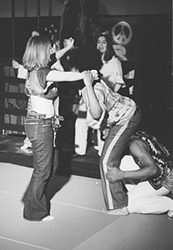

If there's one thing Oberlin has in common with the infamous 1968 musical Hair it is this: Hippies rule. Built on the timeless appeals of free love, rock 'n roll and full frontal nudity, Hair is a work that succinctly captures the ideals of youthful rebellion in a way that remains relevant three decades after its conception.
Senior director Nick Sweeney said, "Even though politics in this country are nowhere near as volatile as they were in the '60s, the themes in Hair are still around us every day." Sweeny will see the labors of his Winter Term come to fruition at this weekend's opening. "Anyone can see how messed up our government is right now. It would do a lot of people good to see it even now."

When things are wrong in the world, Hair offers its own famous solutions: play rock music, do drugs, protest and make love. Simply put, this production of Hair does exactly what it is supposed to do: celebrate the beauty of humanity.
Nothing if not celebratory, this independent production stays very true to Gerome Ragni and James Rado's script, carrying out the celebrations of free love with continuous movement and music. The four-piece band, under the direction of junior Sara Wolfman-Robichaud, aptly covers all bases of the diverse and famous score, going from psychedelica to disco to soul-inspired ballads without a hitch.
"I started preparing over the summer and I really was going to stop at nothing," Wolfman-Robichaud said. "It's been a long and wonderful trip."
But this trip has been much more than a one person journey, and for the cast of almost 20, the trip included learning a demanding and notoriously formidable script and executing the whole performance while dancing. The use of movement with music is without a doubt one of the production's most major accomplishments.
These accomplishments have many careful hours of planning behind them, but those of choreography and physical staging owe all the credit to junior Jose Melendez. Melendez's sense of the Cat in the Cream's less-than-ideal performance space never falters. It is the constant precision and energy of his staging that brings the production to unprecedented heights.
"I wanted to combine the skills used in modern, contact, improv and jazz," said Melendez, who sees his first efforts as a theatrical choreographer performed in this weekend's production of Hair. "It was a really great challenge to me, and it's wonderful to see everything coming together."
And everything does. Overcoming the extreme obstacles with the Cat's weak acoustics and odd logistics by reversing the stage orientation and performing almost in the round, the production changes its limits into benefits and drives with intense energy. Though there are occasional lulls, like when it becomes dialogue-heavy, the overall pacing is very brisk and this can be mostly attributed to the tight band, the smart direction and the engaging and dynamic choreography.
Particular standouts in the cast are hard to single out. All of the voices are right for the parts and the "tribe" chorus is well rehearsed with the signature harmonies that have made the songs of Hair a distinct and valuable part of the musical theater canon. If favorites are to be played, the crushing ballad "Easy to be Hard," performed by junior Kelly Smith, "Sodomy," done by first-year Dan Ronoco and the cast's "Electric Blues" would have to be named.
And for the answer to the question that you've all been waiting for: they do get fully naked. Just as Hair wouldn't be Hair without the D.I.Y sets and the wah-wah guitar, it wouldn't be Hair without the skin.
"We started discussing the nudity issue early on so as not to spring it on the cast at that last minute. After a little time and some good discussion, however, it was hard to get them to keep their clothes on."
Thankfully, when the production comes to a close, the cheap thrill of 20 naked bodies is the furthest thing from one's mind.
The intensity and integrity of Hair's message comes through deafeningly loud to prove that this little play, which functions as a time capsule of 1968, is one of the most timeless treasures of American musical theater.
Free Love For All: The groundbreaking play returns to Oberlin tonight. (photo by Brian Hodgkin)
Copyright © 2000, The Oberlin Review.
Volume 128, Number 14, February 18, 2000
Contact us with your comments and suggestions.